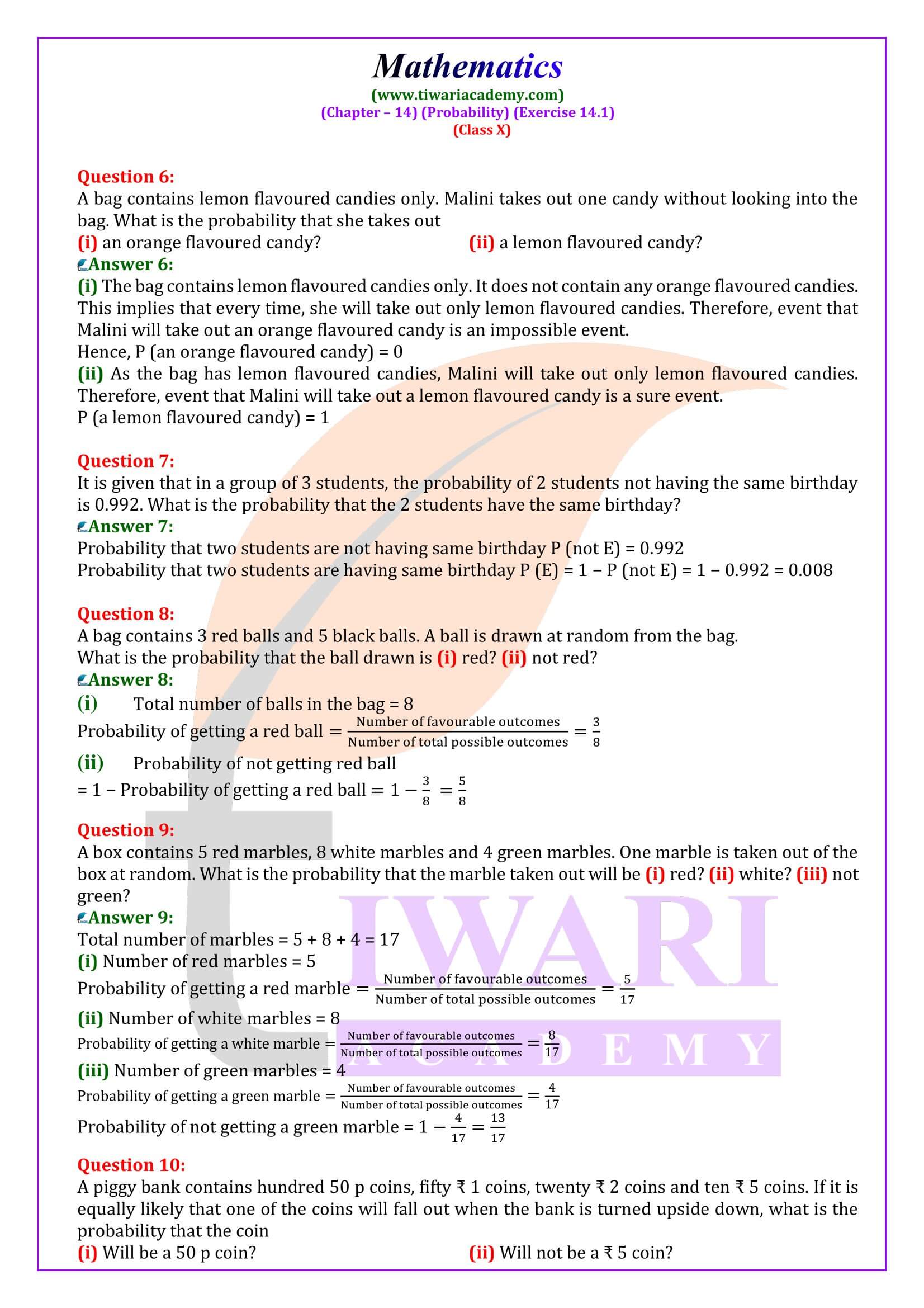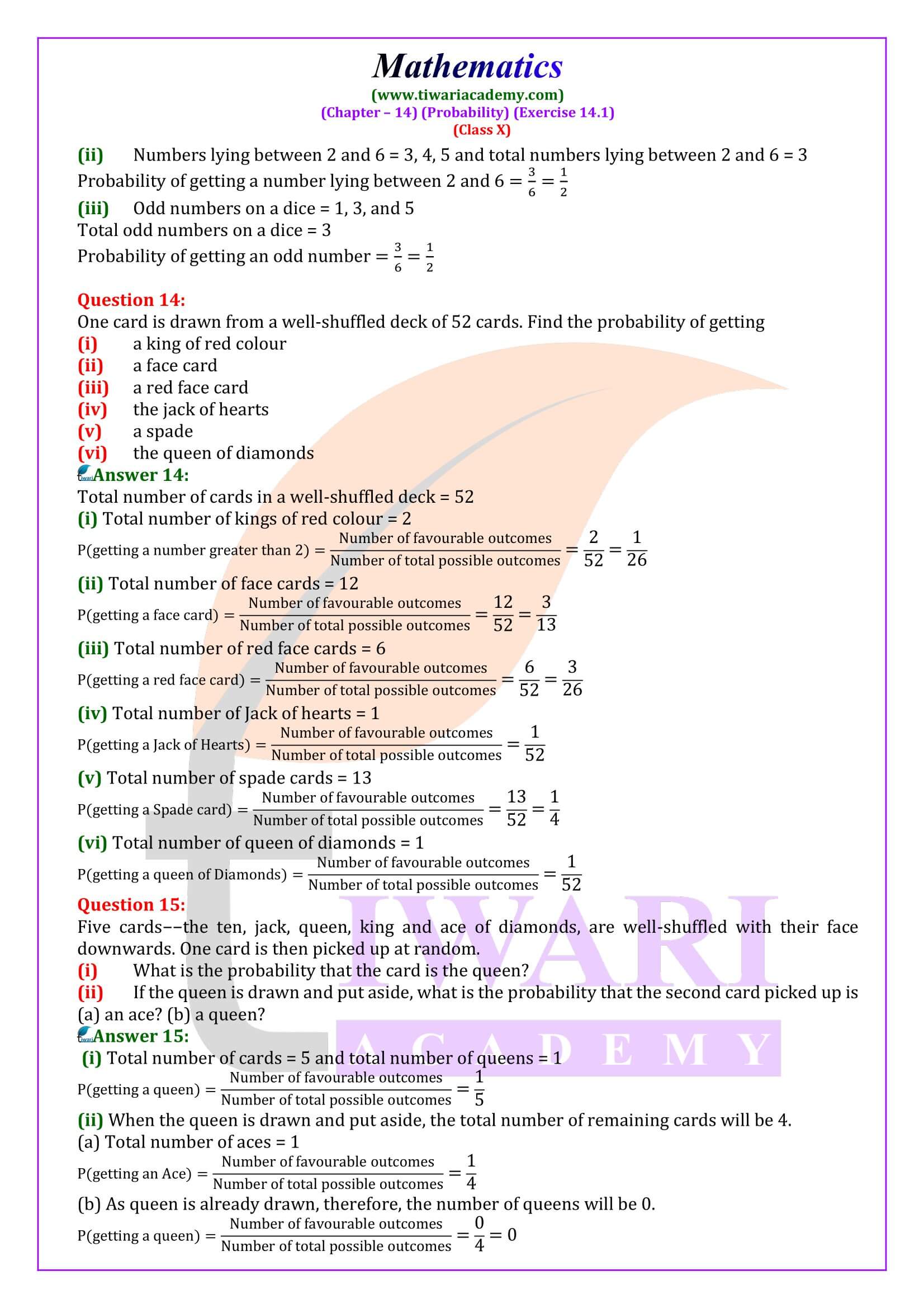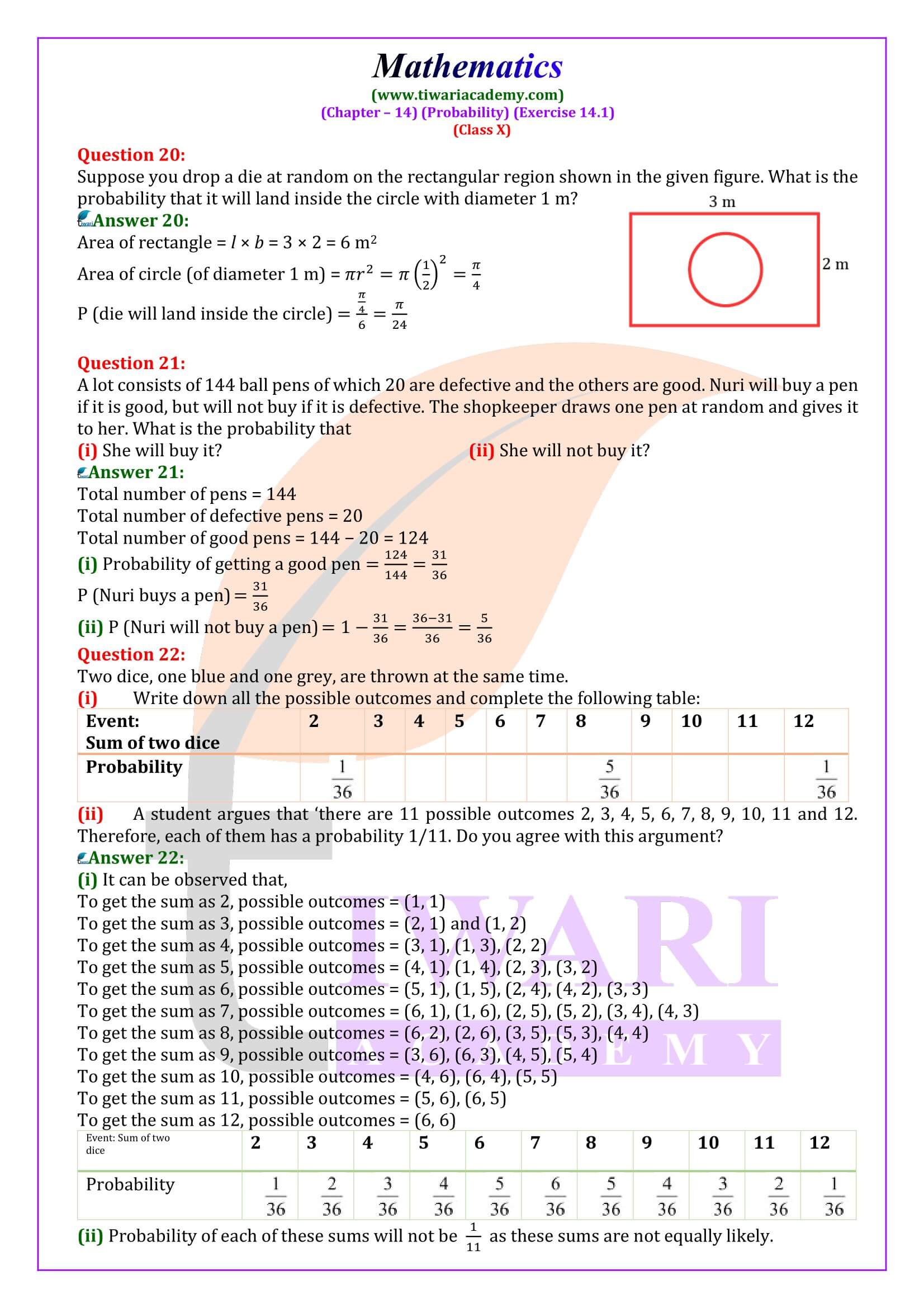NCERT Solutions for Class 10 Maths Chapter 14 Exercise 14.1 Probability in Hindi and English Medium revised and updated for Session 2025-26. As per the new textbooks, there are only one exercise in 10th Maths chapter 14 that is exercise 14.1.
Class 10 Maths Exercise 14.1 Solutions
Class 10 Maths Exercise 14.1 in Hindi
Class 10 Maths NCERT Book Download
Class 10 Maths Chapter 14 Solutions
Class 10 Maths NCERT Solutions
Class 10 all Subjects NCERT Solutions
Class 10 Maths Exercise 14.1 Solution in Hindi and English Medium
To prepare for the exercise in Chapter 14 of Class 10 Maths on Probability, it is important to first have a thorough understanding of the basic concepts such as theoretical probability, equally likely outcomes, and complementary events. Start by practicing each example provided in the chapter, as they form the foundation of understanding how probability calculations work in different scenarios. Focus on solving questions related to tossing coins, rolling dice and drawing cards, as these are common examples that appear frequently in exams. Understanding these basic problems will help build the skills needed to tackle more complex probability questions.

Next, work on solving the exercise thoroughly. Make sure to answer all the questions, paying special attention to those involving real-life scenarios like drawing balls from a bag or selecting cards from a deck. These questions often test your ability to apply probability concepts in practical situations. Practice using formulas like 𝑃(𝐸) = (favorable outcomes)/(total outcomes) and remember that the sum of probabilities for all possible outcomes is always 1. By consistently practicing these problems, you will be well-prepared for the exam and more confident in solving probability questions accurately.
| Class: 10 | Mathematics |
| Chapter: 14 | Exercise: 14.1 |
| Topic Name: | Probability |
| Content: | NCERT Exercise Solutions |
| Session: | CBSE 2025-26 |
| Medium: | Hindi and English Medium |
All the question answers of NCERT Books are solved for CBSE, UP Board, MP Board and all other boards who are using NCERT Textbooks for academic session 2025-26. Contents are based on latest CBSE Syllabus 2025-26 and updated for Exams. Download here, Standard 10 Maths Exercise 14.1 in Hindi and English Medium free of cost. Videos related to each questions are also given here to make study easier and simple.
Class 10 Maths Chapter 14 Exercise 14.1 Solutions in Videos
What is Probability?
Probabilities are based on the results of an actual experiment, then they are called experimental or empirical probabilities. In fact, experimental probabilities are based on the results of a proper record of actual experiments and the occurrence of events. Furthermore, these possibilities are only “estimates”. If we run the same experiment 1000 times, we can get different data which gives different possibilities.
How to find Probability?
Suppose if an experiment is a million times or more that this? And similarly, what would be the experimental probability of a head?” The number of throws, the experimental probability number of a tail or a head is near about to be set to 0.5, which we generally call the theoretical probability of obtaining a head or tail., As you will do in the next section. In Chapter 15 of Standard Mathematics 10, we introduced the theoretical probability of an event (also called classical) and discussed simple problems based on this concept.
Equally Likely Events
Suppose another example of equally likely outcomes, whenever we throw a die once. We always know that a die will always mean a fair die. Can you think, what are the possible outcomes? Yes, it will be 1, 2, 3, 4, 5, 6. Each number has the same possibility to occur. So the equally likely outcomes of throwing a die are 1, 2, 3, 4, 5, and 6.
Probability — A Theoretical Approach
When we talk about a coin, we assume that it is “proper”, that is, it is symmetric, so there is no reason why it should go down more often from one side than the other. We call this property of coin “fair”. By the phrase “random toss”, we mean that the coin can fall freely without bias or interference. We know that the coin can descend only in two possible ways, either above its head or with its tail (we rule out the possibility that it will “land” on its edge, which might be possible, e.g. For, if it falls on the sand). We can reasonably assume that each result, head or tail, is likely to be the other. We refer to this by saying that head and tail are equally likely to result.
Important terms of 10th Maths Exercise 14.1
What is the meaning of probability in mathematics?
Probability is one of the Maths topic where the result is calculated on the basis of previous results. It is totally based on hypothesis. Probability of all events just lie between 0 to 1.
What is simple formula for finding probability?
Probability can be calculated from the following formula:
P(E) = Number of trials in which the event happened/Total number of trials.
How do you find the theoretical probability of an event?
The theoretical probability of an event E, written as P(E), is defined as
P(E) = Number of outcomes favourable to E/Number of all possible outcomes of the experiment.
Assumption Based Probability
By repeatedly experimenting where we formulate some assumptions, repeating an experiment can be avoided because the assumptions help directly calculate the exact (theoretical) probability. The notion of equally likely outcomes (which is valid in many experiments, as in the last two examples, one for coin and one for die) is an assumption that leads us to the next definition of probability of an event.
| Events | Probability |
|---|---|
| Sure Event | 1 |
| Impossible events | 0 |
| Head or tail | 1/2 |
| Number of a die | 1/6 |
| A day of week | 1/7 |
What are the important questions for board in exercise 14.1 of 10th Maths?
In exercise 14.1 of class 10 math, there are 25 questions and 13 examples. Questions 4, 5, 6, 14, 15, 17, 19, 20, 23, 24, 25 and examples 4, 5, 6, 9, 10, 11, 12, 13 of this exercise are important from the exam point of view.
Which questions from exercise 14.1 of class 10 Maths are easy to solve for all students?
Examples 1, 2, 3, 4, 5, 7, 8, 9, 12, 13 and Questions 1 to 14, 16, 19, 21, 23 of exercise 15.1 (class 10 math) are student’s favourite questions and examples because these questions and examples are easy to understand and students solve these questions quickly without any difficulty.
Is exercise 14.1 of class 10th Maths difficult?
Exercise 14.1 of class 10th Maths is not easy and not difficult. It lies in the middle of easy and difficult because some examples and questions of this exercise are easy, and some are difficult. However, the difficulty level of anything varies from student to student. So, exercise 14.1 of class 10th Maths is easy or not depends on students also. Some students find it difficult, some find it easy, and some find it in the middle of easy and difficult.
How much time students need to complete exercise 14.1 of class 10th Maths?
Students need a maximum of five days to complete exercise 14.1 (chapter 14) of class 10th Maths if they give 1-2 hours per day to this exercise. This time also depends on student’s speed, efficiency, capability and many other factors.









